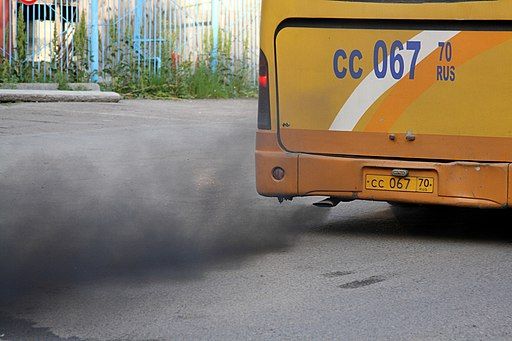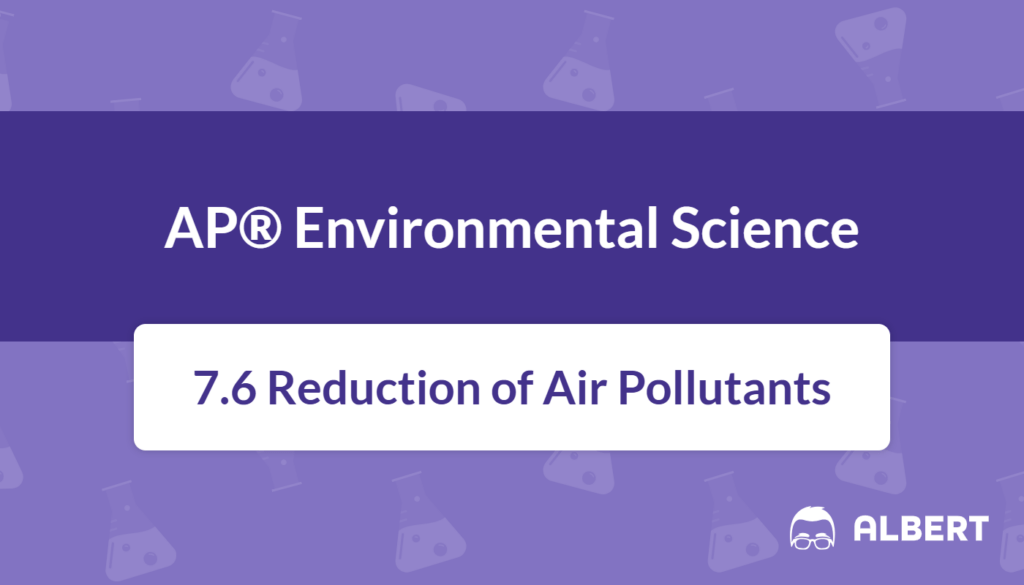What We Review
Introduction
Air pollution remains a major concern for both the environment and human health. It occurs when harmful substances enter the atmosphere faster than natural processes can remove them. Over time, these pollutants can cause everything from respiratory ailments to widespread damage to ecosystems. Consequently, understanding how to reduce air pollutants is an essential part of AP® Environmental Science. Air pollution reduction can limit the negative effects these pollutants have on climate, biodiversity, and public well-being. Therefore, knowing the strategies and technologies that lessen emissions can guide better decision-making at personal, community, and policy levels.
Understanding Air Pollution
Air pollution typically involves the release of chemical, biological, or particulate matter into the atmosphere. These pollutants can be classified into two broad categories:
- Primary pollutants: Emitted directly from sources, such as carbon monoxide from vehicle exhaust.
- Secondary pollutants: Formed when primary pollutants react in the atmosphere, like ground-level ozone created by reactions between nitrogen oxides and volatile organic compounds.
Common sources include motor vehicles, power plants, industrial facilities, and domestic heating. Because these sources are widespread, preventing or reducing pollutants at the source is crucial. Mitigating air pollution is not only about filtering it later but also about minimizing how much pollution is generated in the first place.

Why Reduce Air Pollution?
Air pollution can produce a range of harmful effects. First, there are direct health impacts. Pollutants such as particulate matter (PM) can inflame lung tissue and impair breathing, while sulfur dioxide and nitrogen oxides can trigger asthma attacks. Moreover, long-term exposure to high pollution levels increases risks for heart disease and other chronic conditions.
Additionally, air pollutants can influence the environment. Greenhouse gases warm the planet, leading to climate change. Pollutants like sulfur dioxide help form acid rain, which harms aquatic life and erodes buildings. Meanwhile, excessive pollution reduces agricultural yields because of plant damage and soil nutrient depletion.
Furthermore, the costs related to air pollution are substantial. Hospital visits, missed workdays, and environmental degradation carry high price tags. Therefore, controlling emissions lessens economic stress by avoiding these expenses. In summary, air pollution reduction benefits public health, protects ecosystems, and spares resources.
Methods to Reduce Air Pollutants
There are several methods for air pollution reduction at the source. In these methods can be grouped into three main categories: regulatory practices, conservation practices, and alternative fuels. Each category targets a different aspect of emissions and can be combined for maximum impact.
Regulatory Practices
Regulatory practices include laws, guidelines, and policies that limit allowable emissions for various industries. One major example in the United States is the Clean Air Act. This federal law sets standards for pollutants like particulate matter, sulfur dioxide, and carbon monoxide. When a facility or vehicle surpasses these limits, sanctions and fines can apply.
To illustrate how regulatory mechanisms work, consider a power plant emitting sulfur dioxide (SO₂):
- First, the power plant measures its current SO₂ output.
- Next, the power plant compares these measurements against legal limits established by regulators.
- If emissions exceed limits, the plant must install technologies (like scrubbers) or upgrade its processes to curb SO₂.
- After compliance steps are taken, monitoring systems verify the new emission levels.
Throughout this cycle, regulations encourage accountability by clearly defining permissible levels. Therefore, these rules drive innovations in pollution control.
Conservation Practices
Conservation practices target the root cause of pollution by reducing overall resource use. Lowering energy consumption, for instance, can slash emissions from power plants. Additionally, cutting back on driving leads to fewer exhaust pollutants entering the atmosphere. Energy efficiency in households also contributes significantly to air pollution reduction.
An easy-to-follow example involves calculating the reduction in carbon dioxide emissions through the use of energy-efficient lighting. Suppose a household replaces ten incandescent bulbs, each rated at 60\ \text{W}, with LED bulbs rated at 10\ \text{W}. If each bulb operates for 5 hours per day:
1. Calculate the daily energy use for both bulb types:
- Incandescent: 60\ \text{W} \times 5\ \text{h} = 300\ \text{Wh} (per bulb), which is 0.3\ \text{kWh}.
- LED: 10\ \text{W} \times 5\ \text{h} = 50\ \text{Wh} (per bulb), which is 0.05\ \text{kWh}.
2. Multiply these results by 10 bulbs:
- Incandescent total: 10 \times 0.3\ \text{kWh} = 3\ \text{kWh}.
- LED total: 10 \times 0.05\ \text{kWh} = 0.5\ \text{kWh}.
3. If the power plant’s emission factor is 0.5\ \text{kg} \ CO_2/\text{kWh}, the daily CO₂ emissions for each lighting choice become:
- Incandescent: 3\ \text{kWh} \times 0.5\ \text{kg} \ CO_2/\text{kWh} = 1.5\ \text{kg} \ CO_2.
- LED: 0.5\ \text{kWh} \times 0.5\ \text{kg}\ CO_2/\text{kWh} = 0.25\ \text{kg}\ CO_2.
4. The difference is 1.25\ \text{kg}\ CO_2 fewer emissions per day simply by switching to LED bulbs.
Therefore, conservation and efficiency strategies can greatly reduce emissions when practiced on a large scale.
Alternative Fuels
Another major way to limit air pollution at the source is through the use of cleaner energy sources. Biofuels, hydrogen, and electricity can all replace or reduce conventional gasoline and diesel consumption. Indeed, electric vehicles (EVs) emit significantly less tailpipe pollution than traditional vehicles since they do not burn gasoline.
Consider a step-by-step comparison for a single passenger car over 10,000 miles:
- A gasoline car might produce approximately 0.35\ \text{kg} \ CO_2/\text{mile}.
- Hence, total emissions for 10,000 miles become 0.35 \times 10{,}000 = 3{,}500\ \text{kg} \ CO_2.
- An EV might indirectly produce around 0.15\ \text{kg} \ CO_2/\text{mile}, factoring in electricity generation sources.
- Consequently, total emissions would be 0.15 \times 10{,}000 = 1{,}500\ \text{kg} \ CO_2.
- The reduction in this scenario is 3{,}500 - 1{,}500 = 2{,}000\ \text{kg} \ CO_2 over 10,000 miles.
Although real-world figures vary, such comparisons highlight how shifting to alternative fuels can cut pollution considerably.
Technology and Air Pollution Control Devices
Technologies designed to trap or convert pollutants before release form an essential line of defense. These devices often work in tandem with regulatory standards that require installation and proper maintenance. Meanwhile, they play a crucial role in industrial operations as well as everyday activities like refueling vehicles.
Vapor Recovery Nozzles
A vapor recovery nozzle is common at gasoline pumps. It captures fuel vapors before they escape, lowering volatile organic compound (VOC) emissions. VOCs can interact with nitrogen oxides in sunlight, forming ground-level ozone (a secondary pollutant). By preventing vapors from escaping, vapor recovery nozzles reduce ozone formation at the source.
For example, if a standard gasoline nozzle allows 0.02\ \text{liters} of vapor per liter of fuel to escape, then refueling 50 liters would lose 1\ \text{liter} of vapor. Over time, this loss multiplies across millions of vehicles. Therefore, vapor recovery nozzles minimize these cumulative emissions.
Catalytic Converters
Catalytic converters are installed in a vehicle’s exhaust system. They use chemical reactions to convert harmful gases into less harmful substances. For instance, carbon monoxide (CO) is turned into carbon dioxide (CO₂), and nitrogen oxides (NOₓ) are reduced to nitrogen (N₂) and oxygen (O₂). Hydrocarbons are transformed into water (H₂O) and CO₂.
In practice, a catalytic converter operates by:
- Receiving exhaust gases containing CO, NOₓ, and unburned hydrocarbons.
- Passing them over a catalyst, often made of platinum or palladium.
- Encouraging oxidation of CO and hydrocarbons into CO₂ and H₂O, while NOₓ breaks down to nitrogen and oxygen.
Thus, catalytic converters drastically cut emissions leaving the tailpipe.
Wet and Dry Scrubbers
Used mainly in industrial settings, scrubbers reduce airborne pollutants by removing particulates and other unwanted compounds from exhaust streams. They come in two main types:
- Wet scrubbers: These devices pass hot exhaust gases through a liquid solution (often water combined with chemical reagents) that traps particles and dissolves or reacts with pollutant gases.
- Dry scrubbers: Instead of a liquid, these units utilize dry sorbent materials (such as lime). Pollutants chemically bind to the sorbent particles and can then be removed as a solid waste.
For a step-by-step view of a wet scrubber on a coal-burning power plant:
- Exhaust gases enter a chamber containing water spray or a liquid slurry with reagents.
- Pollutants, such as sulfur dioxide, dissolve in the water or react with added chemicals.
- Solid by-products or dissolved substances collect in a basin.
- Treated gases exit with far fewer pollutants.
Meanwhile, dry scrubbers follow a similar principle but rely on solid rather than liquid reagents.
Case Studies: Successful Air Pollution Reduction
Several regions worldwide demonstrate how strategic action can significantly reduce air pollution:
- In California, strict statewide emission standards have improved air quality over recent decades. Regulatory efforts made catalytic converters mandatory and refined fuel standards, decreasing smog levels.
- In London, introduction of low-emission zones and congestion charges has limited the number of highly polluting vehicles in the city center.
- In Beijing, a mix of regulations, temporary shutdowns of highly polluting factories, and traffic controls has helped lower severe air pollution episodes.
In each case, a balance of technology upgrades, strict rules, and public awareness contributed to cleaner air.
Conclusion
Air pollution reduction is vital for protecting both ecosystems and communities. While it may seem like a challenge, there are numerous tools available: strong regulations, practical conservation methods, and effective alternative fuels all mitigate the harmful effects of large-scale emissions. Moreover, specific technologies—such as vapor recovery nozzles, catalytic converters, and scrubbers—further minimize pollutants before they reach the atmosphere. By combining these strategies, societies can curb detrimental impacts, conserve resources, and guide future advancements in the field of environmental management.
Important Vocabulary
- Air Pollution: The presence of harmful substances in the atmosphere that pose risks to health and the environment.
- Vapor Recovery Nozzle: An air pollution control device on a gasoline pump that prevents fuel fumes from escaping into the atmosphere when fueling a motor vehicle.
- Catalytic Converter: A device in vehicle exhaust systems that converts pollutants (CO, NOx, and hydrocarbons) into less harmful molecules (CO₂, N₂, O₂, and H₂O).
- Wet Scrubbers: Systems that use water or other liquids to remove particulates and gases from industrial exhaust streams.
- Dry Scrubbers: Systems that rely on solid sorbent materials to react with and capture pollutants from industrial exhaust.
Sharpen Your Skills for AP® Environmental Science
Are you preparing for the AP® Environmental Science test? We’ve got you covered! Try our review articles designed to help you confidently tackle real-world AP® Environmental Science problems. You’ll find everything you need to succeed, from quick tips to detailed strategies. Start exploring now!
- AP® Environmental Science: 7.3 Review
- AP® Environmental Science: 7.4 Review
- AP® Environmental Science: 7.5 Review
Need help preparing for your AP® Environmental Science exam?
Albert has hundreds of AP® Environmental Science practice questions, free response, and full-length practice tests to try out.








